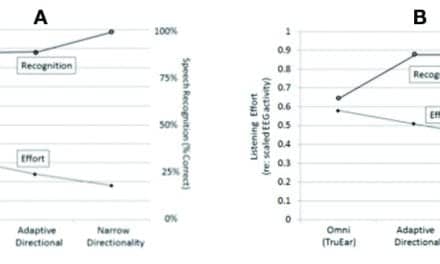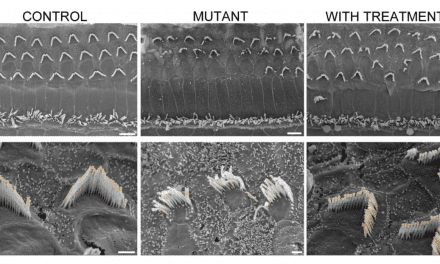Our ears are exquisite detection instruments, capable of discerning a whisper or distinct notes of music within a symphony. To pick up these sounds, tiny hair-like filaments in the inner ear must be packed into precisely arranged bundles, all facing the same direction. Images of the normal, tidy architecture of these bundles on cells within the cochlea, the inner ear structure responsible for hearing, were captured by researchers in A. James Hudspeth’s lab at The Rockefeller University, the school announced on its website. This is part of an effort to understand how these hair bundles are constructed and aligned. Together with a collaborator at The Jackson Laboratory, they have recently identified a molecule that coordinates this process, a discovery that helps explain an important stage in the development of our sense of hearing.
Scientists already knew that a molecular blueprint guides the formation of upside-down V-shaped bundles on the surface of inner ear cells that detect sound, motion, and spatial orientation. While investigating how cells draw up these blueprints, Kimberly Siletti, a graduate student in the lab, found evidence implicating a protein called Daple. It was already known to interact with a so-called compass structure, ensuring that the V-shape bundles are aligned properly to catch sound propagating through the cochlea.

Inner-ear filaments bundled, facing the same direction (top image). Bundles without the Daple protein that appear scrambled (bottom image).
Understanding these molecular orientation systems is critical because if disrupted the bundles grow facing the wrong direction, sometimes even backward. For the bundle to develop properly, the blueprint and the compass must work together.
“These two systems were discovered independently, and it isn’t clear how they are coordinated,” Siletti says. “Our experiments suggest that Daple is part of the molecular machinery that links them.”
To test this hypothesis, the researchers switched off the protein in mice. The effect of this manipulation, captured in high-resolution, was conspicuous: the hair cells of animals that lacked the protein developed scrambled bundles without the distinctive V-shape.
The scientists think Daple influences the shape of the hair bundles indirectly, by determining the position of the first filament to emerge at what becomes the apex of each bundle. If that filament is positioned improperly, the blueprint becomes warped. Their work was described in the Proceedings of the National Academy of Sciences.





